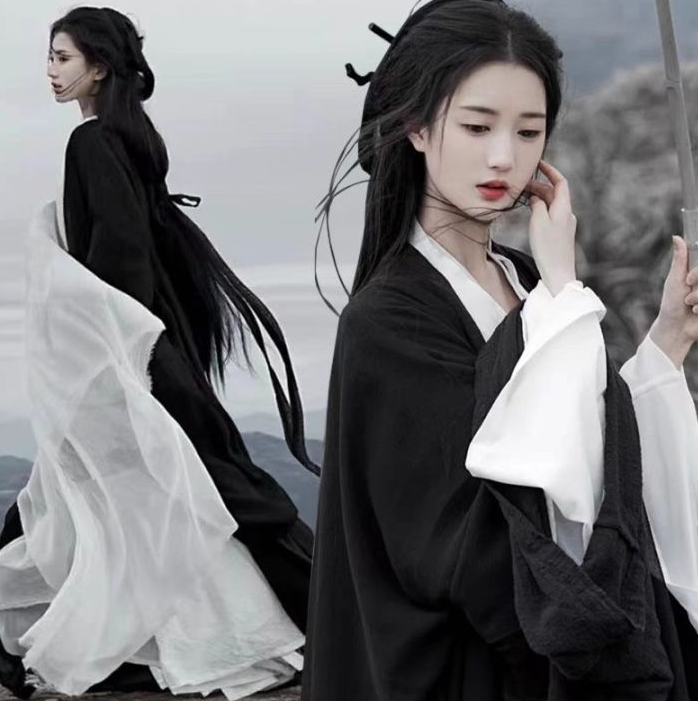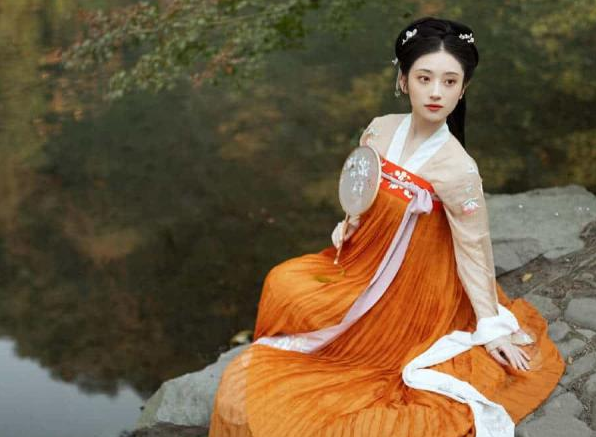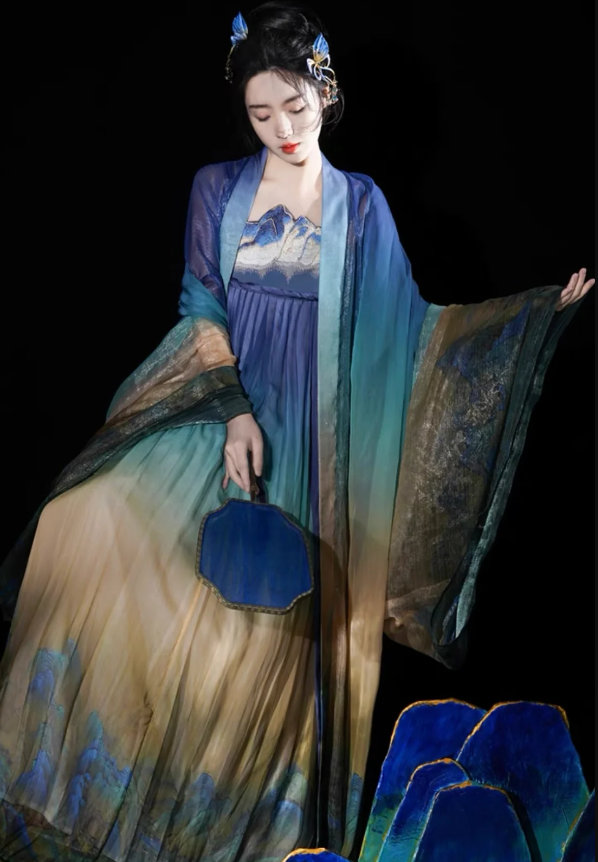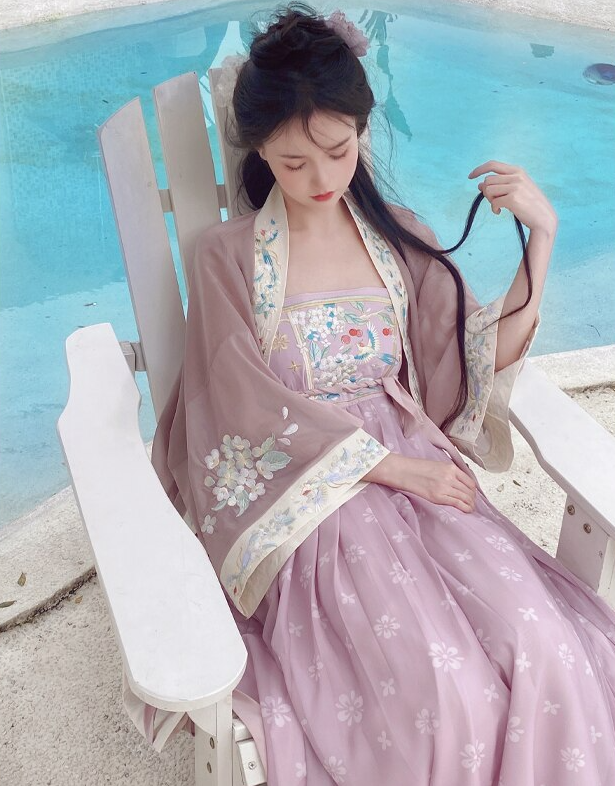Hanfu colours range from traditional shades like red, blue, and yellow to modern hues and seasonal variations.
Basic Colour Palette in Traditional Hanfu
The vibrant and diverse colour palette of traditional Hanfu clothing is a testament to the rich cultural and aesthetic traditions of ancient China. Each colour wasn’t merely a visual delight; they carried deep symbolic meanings and told stories of history, nature, and philosophy.

The Five Cardinal Colours: Blue, Red, Yellow, White, Black
These five colours, also known as the Wu Xing colours, represent the basic elements of the universe according to Chinese philosophy. They are integral to the Chinese worldview and have profound connotations in different contexts, be it in art, attire, or architecture.
- Blue (青 Qīng): Often symbolizing the wood element, blue is associated with spring, growth, and vitality. It’s common to see Hanfu garments in various shades of blue, representing youth and freshness. Learn more on Wikipedia.
- Red (红 Hóng): Representing the fire element, red is synonymous with passion, luck, and happiness in Chinese culture. It’s a predominant colour in festive occasions and ceremonies, symbolizing good fortune and joy.
- Yellow (黄 Huáng): Symbolizing the earth element, yellow was often reserved for the emperor in ancient China, representing his central role in the universe. Yellow Hanfu signifies neutrality and is also a representation of the golden harvest of autumn. Learn more on Wikipedia.
- White (白 Bái): Representing the metal element, white signifies purity, innocence, and mourning. In traditional Hanfu attire, white is often used in funeral rites and symbolizes reverence for the departed.
- Black (黑 Hēi): Associated with the water element, black represents the unknown, the infinite, and winter. It’s seen as a colour of depth, mystery, and contemplation.
Symbolism and Significance
The colours in Hanfu aren’t arbitrary. They are chosen with intention, reflecting the wearer’s status, the occasion, the season, or even the wearer’s emotions. For instance, while red might be preferred for a wedding, signifying joy and prosperity, white would be chosen for funerals, symbolizing mourning and respect for the deceased. Each colour tells a story, echoing the philosophies, nature, and the very elements that make up the universe. Through Hanfu, one doesn’t just wear a garment; they wear a piece of history, tradition, and symbolism. Learn more on Wikipedia.
Hanfu Colours for Different Seasons
The exquisite art of Hanfu dressing is intrinsically tied to the rhythms of nature. As the seasons change, so do the colours of Hanfu, mirroring the evolving landscape and the moods it evokes. These colours aren’t just aesthetically pleasing; they resonate with the deep-rooted Chinese philosophy that emphasizes harmony with nature.
Spring: Pastels and Fresh Hues
Spring is a time of rejuvenation and renewal. As flowers bloom and trees sprout new leaves, Hanfu dresses in this season reflect the youthful energy of nature. Soft pastels like lavender, peach, and light green dominate, mirroring the blossoms and fresh foliage. Wearing such hues is akin to celebrating the rebirth of the world after winter’s slumber. A peek into history reveals that these choices are steeped in tradition and symbolism, going beyond mere fashion.
Summer: Bright and Vivid Tones
Summer, with its abundance of life and warmth, brings Hanfu in bold and radiant colours. Think of the deep blues of the summer sky, the vibrant reds of blooming flowers, and the golden yellows of the sun. These hues are not just a nod to the beauty of the season but also a way to express joy, vitality, and the fullness of life. When one dons a bright Hanfu in summer, they’re truly embodying the spirit of the season.
Autumn: Warm and Earthy Shades
As the leaves change and the world is painted in shades of amber, rust, and brown, Hanfu colours transition to warmer, earthier tones. These colours are a tribute to the harvest season, representing abundance, gratitude, and the transient beauty of nature. Wearing Hanfu in shades like maroon, ochre, and olive is a way of harmonizing with the changing landscape and paying homage to the cycle of life and decay. Historical records often depict scholars and poets wearing these colours, lost in contemplation of nature’s beauty.
Winter: Deep and Muted Colours
Winter is a time of introspection, quiet, and stillness. Hanfu dresses during this season reflect these moods with deeper, muted colours like charcoal, navy, and deep purples. These shades resonate with the long nights and the cool, introspective ambiance of winter. Wearing them is a way to find warmth and comfort in the cold, and to connect with the inner self during this period of rest and reflection. It’s a tradition that’s been preserved through the ages, a testament to the enduring beauty of Hanfu and its symbiotic relationship with nature.
Special Occasion Hanfu Colours
In the tapestry of Chinese traditions, Hanfu stands out as a vibrant thread, weaving together cultural symbolism, aesthetic appeal, and profound meaning. While everyday Hanfu dresses mirror the seasons and moods, the colours for special occasions are even more significant. They are chosen not just for their visual appeal but for the deep cultural and symbolic messages they convey.
Wedding Hanfu: Reds and Golds
In Chinese culture, a wedding is more than just a union of two people; it’s a harmonious merging of two families and a celebration of love, prosperity, and future blessings. The predominant colour for wedding Hanfu is red, a symbol of joy, love, and good fortune. Gold, often used as an accent or embroidery on red Hanfu, signifies wealth, prosperity, and grandeur. Together, red and gold create a palette that wishes the newlyweds a life filled with happiness, wealth, and blessings. When one sees a bride in a radiant red Hanfu adorned with golden motifs, they’re witnessing centuries of tradition and cultural significance.
Funeral Hanfu: Whites and Blues
In stark contrast to the celebratory colours of weddings, funerals in Chinese traditions are somber occasions, a time to mourn, remember, and pay respects. White is the predominant colour for funeral Hanfu, symbolizing purity, mourning, and reverence for the departed soul. Blue, another common colour, reflects the vastness of the afterlife and the depth of sorrow. These colours aren’t mere fashion choices but a deep-rooted expression of respect, grief, and the philosophical understanding of life, death, and the cycle of existence.

Festival Hanfu: Varied Bright Shades
Festivals in China are exuberant celebrations, marking various historical, seasonal, or religious events. Hanfu worn during these occasions is as diverse and vibrant as the festivals themselves. Bright greens during the Dragon Boat Festival, radiant reds during Lunar New Year, and a spectrum of colours during the Mid-Autumn Festival. Each colour, pattern, and style tells a story of the festival’s origin, its significance, and the collective joy of the community. Donning these colourful Hanfu is more than just participating in a festival; it’s becoming a part of a living, breathing tapestry of traditions.
Colours and Social Status in Ancient China
The nuances of colour in ancient Chinese attire were not just a reflection of aesthetic choices or seasonal variations. They played a pivotal role in denoting social hierarchy, with certain shades reserved exclusively for specific classes. This demarcation was both a visual representation of status and a manifestation of the Confucian values that deeply influenced society’s structure and norms.
Royalty and Nobility: Purples, Golds, and Rich Tones
Purple, often seen as a royal hue worldwide, held a similar significance in ancient China. This majestic shade, especially when combined with gold, was emblematic of power, wealth, and divine favor. Wearing purple was a prerogative of the emperor, the dragon’s earthly embodiment, and by extension, the higher echelons of nobility. Gold, symbolizing unmatched wealth and prosperity, frequently adorned the robes of the royal family, making them stand out in any gathering.
These rich tones were not just markers of social standing but also an assertion of divine right and mandate. For anyone outside the designated class to adorn these colors was seen as an affront, a challenge to the established order, and could be met with severe penalties. By reserving these colours for the elite, ancient Chinese society visually reinforced the hierarchy and the celestial mandate that justified it. This association of colours with royalty and nobility has left an indelible mark, influencing Chinese art, literature, and culture for centuries.
Commoners: Neutral and Simple Shades
In stark contrast to the flamboyance of royalty, the commoners’ palette was muted and earthy. Neutrals like browns, grays, and undyed creams dominated the attire of the masses. These shades, sourced from easily available natural dyes and materials, were both economical and in line with Confucian values of simplicity, humility, and harmony with nature.
While these colours might seem plain compared to the royal palette, they had their own aesthetic appeal, resonating with the landscapes and the everyday lives of the people. Moreover, they symbolized the collective spirit, hard work, and resilience of the common people, the backbone of the empire. Through their attire, commoners showcased their role in the grand tapestry of the kingdom, as the foundation supporting the opulence and grandeur of the elite. This distinction in colour and attire is a fascinating lens to explore the social dynamics and values of ancient China.
Dyes and Materials Used in Hanfu Colouring
The vibrant and varied colours of Hanfu clothing aren’t just a testament to ancient China’s aesthetic sensibilities, but also to their prowess in material science, chemistry, and craftsmanship. The art of dyeing was intricate, requiring both knowledge of natural resources and the skills to transform these resources into lasting, brilliant colours on fabric.

Natural Plant Dyes: Indigo, Safflower, and More
Plant-based dyes have been the cornerstone of textile colouring for millennia. Among the most prominent is indigo, derived from the leaves of certain plant species, which gives a distinctive blue shade. Its rich hue and ability to adhere well to fabrics made it a favourite among craftsmen.
Safflower, another popular choice, was primarily used for its red and pink shades. The process of extracting the right colour from safflower was meticulous, making the final product even more prized. Various other plants, such as the black walnut for deep brown and certain roots and barks for yellows and tans, played crucial roles in the Hanfu colour spectrum. These natural dyes, in addition to their visual appeal, often had a symbolic or cultural significance, amplifying the garment’s meaning and value.
Animal-Based Dyes: Cinnabar, Shellfish Purple
While plants provided a wide colour palette, certain animal-based materials were invaluable for specific shades. Cinnabar, a mineral often associated with mercury, was used to produce vibrant reds. Though not directly an animal product, its extraction and usage often intertwined with various rituals and beliefs about the animal kingdom.
Shellfish purple, derived from specific mollusks, was another luxury dye. The process of obtaining this dye was labor-intensive, requiring thousands of mollusks for a small amount. This rarity and the deep, rich purple it produced made it especially cherished and often reserved for nobility or special occasions. The prestige associated with these dyes often gave them cultural or symbolic importance, echoing the societal values and hierarchies of the time.
Evolution of Dyeing Techniques
The art and science of dyeing evolved significantly through the dynasties. Initially, simple immersion techniques were used, where fabrics were soaked in dye solutions. With time, resist dyeing, where parts of the fabric were prevented from taking on colour, and mordant dyeing, which used agents to fix the dyes better to the fabrics, became popular.
Modern Hanfu and Colour Trends
As with all traditional wear across the globe, Hanfu has not remained static. Instead, it has evolved, adapted, and transformed, reflecting the ebb and flow of cultural, social, and aesthetic changes in China. In recent times, the resurgence of Hanfu as a fashion statement among the younger generation has brought with it both a nostalgia for ancient shades and an infusion of contemporary colours, leading to a fascinating blend of the old and new.
Revival of Ancient Shades
The modern Hanfu movement, fueled by a renewed interest in China’s rich history and cultural heritage, has seen a comeback of many traditional shades. Indigo blues, safflower reds, and natural tans have all experienced a resurgence, as enthusiasts and designers alike look back to ancient techniques and motifs for inspiration. This revival isn’t just about aesthetics. It’s also a journey into the past, reconnecting with ancestral roots and rediscovering the profound symbolism embedded in these hues. By wearing these colours, modern Hanfu enthusiasts engage in a dialogue with history, paying homage to bygone eras and keeping alive the rich tapestry of Chinese traditions.

Incorporation of Modern Palettes
While the reverence for traditional colours remains strong, the modern Hanfu movement is anything but orthodox. Today’s designers experiment with contemporary shades, introducing pastels, neons, and other modern hues to the Hanfu palette. These new shades, while not traditional, resonate with the global fashion scene and the preferences of today’s youth. Neon greens, electric blues, and soft pastels have all found their way onto Hanfu robes, reflecting the dynamism and adaptability of this age-old attire. This incorporation of modern palettes ensures that while Hanfu remains deeply rooted in tradition, it is also in sync with contemporary fashion trends.
The Fusion of Tradition and Modernity
At the heart of the modern Hanfu movement is a delicate balance between the old and the new. It’s about respecting and celebrating the past while embracing the future. This fusion is most evident in the colour trends, where ancient shades coexist harmoniously with modern tints.